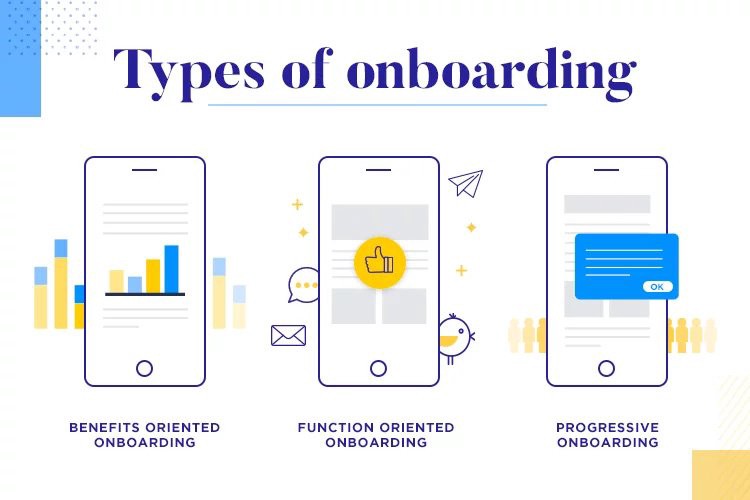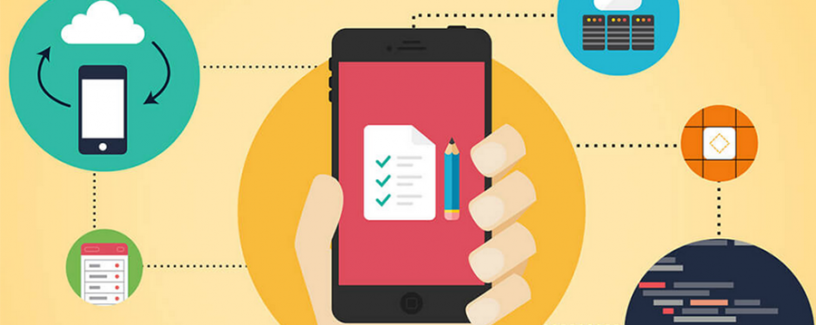As mobile app usage becomes more widespread, it’s important for developers to create an onboarding experience that helps new users get up to speed quickly and effectively. An effective mobile app onboarding flow, will introduce the key features of the app and guide users through its core functionality.
Onboarding is especially important for mobile apps because the small screen size means there is less room for error. If users can’t figure out how to use your app, they’ll likely give up and delete it, fast.
A well-designed mobile app onboarding process can help new users understand your app and its features, whilst reducing their frustration, and promoting their engagement. Read on to discover our tips on what’s most important to keep in mind when designing your mobile app onboarding flow.
Looking for proof that mobile on boarding matters? Just take a look at these statistics;
- 64% of mobile app users say they would only give an app a second chance if it had a good onboarding experience
- 79% of mobile app users say they would only use an app again if it lived up to their expectations
- 80% of mobile app users say they would only use an app again if it was easy to use
There is no doubt that mobile app onboarding is essential to the success of your app. By taking the time to design a thoughtful and effective mobile onboarding flow, you can ensure that your users have a positive experience with your app from the very first time they engage with it.
What is App Onboarding?
Mobile app onboarding is the process of introducing new users to your app and its features. The goal of mobile app onboarding is to help users understand how to use your app so that they can get the most out of it.
A well-designed mobile app onboarding flow will walk users through the key features of your app and help them understand its core functionality. Due to the comparatively small screen size of mobile devices, onboarding is especially important for mobile apps because there is less room for error. If users can’t figure out how to use your app, they’ll likely give up and delete it.
Types of Onboarding
You can adopt many sorts of app onboarding based on the nature of your business and app. All of these onboarding techniques empower users and encourage them to learn through exploration of the application.

1. Benefits-Oriented Onboarding
In an effort to boost conversion, this type of onboarding emphasises the benefits or value the user will receive from the app. This strategy highlights the app’s functionality rather than its usage. These onboarding screens will also contain opt-in permission requests, such as accessing the user’s location and delivering push alerts.
2. Functional onboarding
This strategy emphasises the app’s functionality by instructing the user on how to utilize the app. The user will receive a guided tour of the application with precise instructions on how to get started and carry out various tasks.
3. Progressive onboarding
Progressive onboarding is somewhat more comprehensive, as it presents users with fresh information as they walk around the application. Similar to a live tour, the instructions displayed on the screen correspond to the website the user is currently viewing. Instead of receiving instructions upfront, users will learn as they navigate the application.
When does a mobile app need onboarding?
A user onboard a mobile app the first time they open it. If a mobile app has complex navigation or set of features, it needs an onboarding experience to help users understand how to use it.
Why is mobile app onboarding beneficial?
- It reduces frustration for users
- Helps users understand your app
- Promotes engagement with your app
- Can increase retention rates
What are the components of an effective mobile onboarding flow?
There are four key components to a mobile onboarding flow: introduction, tour, login, and next steps. Let’s take a closer look at each of these.
- Introduction: The first step in your mobile onboarding flow should be an introduction to the app. This is where you’ll give users a brief overview of the app’s key features and benefits.
- Tour: The next step is to provide a tour of the app. This is where you’ll walk users through the app’s core functionality and show them how to use its various features.
- Login: Once users have been introduced to the app and given a tour of its functionality, it’s time to login. This is where users will create an account or login with an existing account.
- Next Steps: After users have logged in, it’s time to provide next steps. This is where you’ll give users directions on what to do next, such as exploring the app’s features or completing a task.
By following this mobile onboarding flow, you can ensure that users are introduced to the app in a way that is both informative and engaging.
Mobile app onboarding best practices
When designing your mobile app onboarding flow, there are a few best practices to keep in mind:
-
Prioritize Value Proposition
It is believed that by providing the appropriate tools to users, it’s possible to turn them into active users. By highlighting the best aspects of your app, you may convince users to download it. However, you will be more successful if you emphasize the value proposition of your app first.
Instead of highlighting your app’s features first, describe what the user would gain from utilising it. It will not only encourage people to use your app in the future, but it will also reassure them that the app is functional and fulfils its advertised purpose.
After this, you can demonstrate the major features and functionalities of your software that will aid users in achieving their intended duties.
-
Keep it short and sweet
Mobile app users have short attention spans, so it’s important to keep your mobile onboarding flow concise and to-the-point. Avoid overwhelming users with too much information at once.
-
Request Only Required Information
If your app is about studying cultures, it wouldn’t make sense to ask users about their favourite chef’s, would it? Rather, in this situation, you would need to request the most pertinent and essential facts. According to a report, almost 60 percent of consumers don’t install an app, or uninstall it later if they believe the program is requesting too much personal information from them.
Also, avoid bombarding users with too many inquiries. Try to make your question list as short and specific as possible. This is one of the most efficient onboarding strategies for increasing app user engagement.
-
Use visuals
Use images and videos to help explain complex concepts. Visuals are especially helpful for mobile app users as they can help break down information into smaller, more manageable pieces.
-
Utilise Empty States
Empty states refer to the screens that appear when neither the user is engaging, nor has any content yet been contributed. You can take advantage of these empty states by utilising them to encourage your user to use your app. For example, you may educate, direct and encourage users to take action instead of leaving a blank space. For example, Instagram displays “No posts yet” rather than leaving the page blank. This motivates users to take action and continue using the application.
-
Use Gamification
Gamification is a great way to engage mobile app users and keep them coming back for more. By incorporating elements of game design into your mobile onboarding flow, you can make the experience more fun and engaging for users.
-
Time-to-value
During the initial encounter between a consumer and your app, you have a limited amount of time to capture their attention. To retain customers, you should be able to demonstrate the value of your product, quickly. As an example of time-to-value, consider Whatsapp, a successful app that provides instant benefit to its users. As you know, there are only a few steps required to begin using WhatsApp for communicating. They do not request an excessive amount of information, or effort from the user, therefore users discover value after completing the initial tasks.
-
Personalization
58% of smartphone users prefer companies that have mobile sites or apps that remember who they are. Take, for example, Spotify. It’s no surprise that this app is so popular among users. Spotify gives users options based on language, genre, artists, and so on to begin personalising the content that’s been recommended to them from the start.

-
App Content Preview
One of the onboarding app best practises to consider in 2022 and beyond, is promoting app content preview. This is due to the fact that a sign-up option can serve as a barrier between your app and the user. As a result, it is always preferable to give users access to your app’s features before asking them to sign up. For example, if you own an online store app, allow users to browse the products available on your website, and when they want to make a purchase, they can simply login. Alternatively, after users have discovered your app, you can enable the login option.
-
Test, test, test
Always test your mobile onboarding flow before launch. This will help you identify any areas that need improvement and ensure that the experience is as smooth and user-friendly as possible.
-
Using CTAs
If your users must complete a series of steps, you should use CTAs to guide them.
You should inform users about each step briefly and encourage them to take action using CTAs.
-
Allow the option to skip
Providing different and alternate options is what users all over the world value the most. For whatever reason, some users may prefer to skip the entire app onboarding process. Giving them this option will instantly improve your app’s reputation, and users may continue to use it in the future.
By following these best practices, you can ensure that your mobile app onboarding flow is both effective and engaging.
Mobile App Onboarding Templates
If you’re looking for some inspiration for your mobile app onboarding flow, check out these templates:
1. AppInstitute
AppInstitute’s mobile app onboarding template is a great starting point for designing your own mobile onboarding flow.
2. Stripe
Stripe’s mobile onboarding template is another great option for designing your mobile app onboarding flow.
3. Google Material Design
Google’s Material Design guidelines are a great resource for designing an engaging and user-friendly mobile app onboarding experience.
By using these templates, you can ensure that your mobile app onboarding flow is both effective and engaging.
Final Thoughts
We, at Appomate, want to help you understand what mobile app onboarding is and how a successful onboarding process can set you apart from your competitors.
App onboarding is required for smaller firms or startups to get client insights by:
- Providing a consistent user experience
- Enabling an effective lead generation tool
- Identifying your consumers by name and face
Activating this app onboarding procedure for your small business clients will result in a significant increase in app conversions. This will result in long-term revenue growth, and you, as the reseller, will be able to demonstrate the app’s return on investment. Both parties win! Contact us for more information or clarity, on the significance of onboarding for your app.
